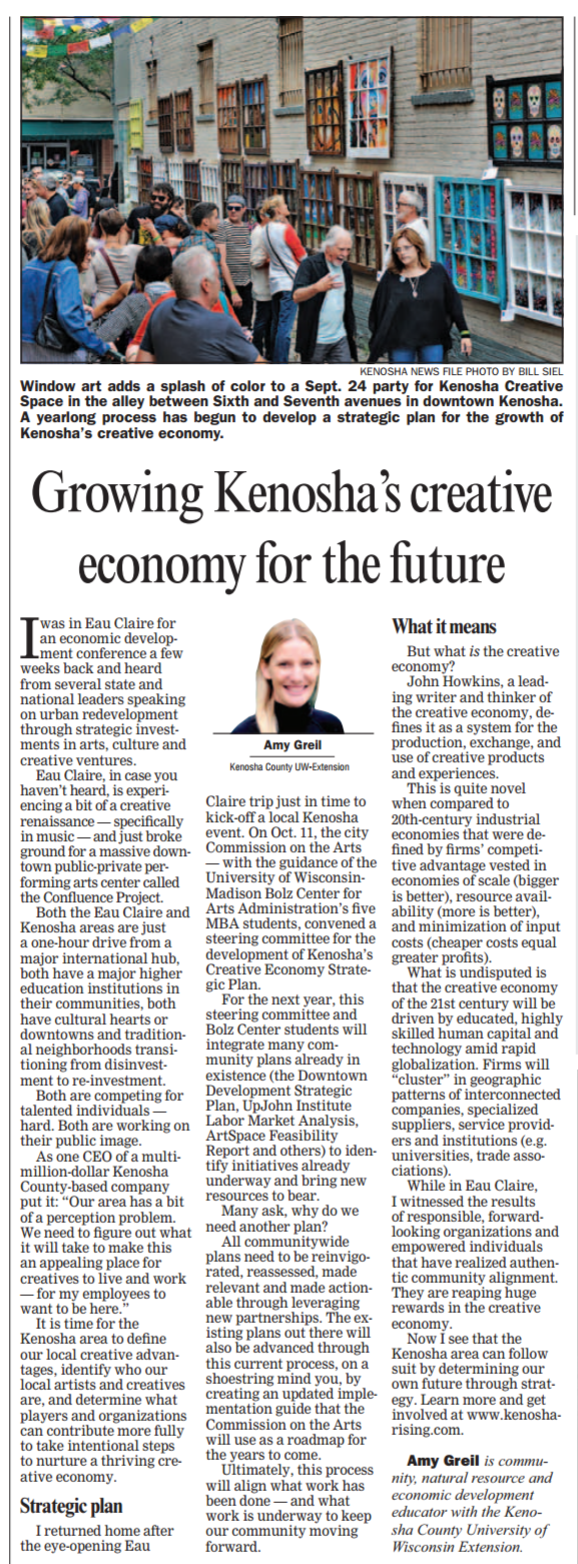Strategic planning process underway

BY AMY GREIL
KENOSHA COUNTY UW-EXTENSION
As published in the Kenosha News – Saturday, October 22, 2016
I was in Eau Claire for an economic development conference a few weeks back and heard from several state and national leaders speaking on urban redevelopment through strategic investments in arts, culture and creative ventures.
Eau Claire, in case you haven’t heard, is experiencing a bit of a creative renaissance — specifically in music — and just broke ground for a massive downtown public-private performing arts center called the Confluence Project.
Both the Eau Claire and Kenosha areas are just one hour’s drive from a major international hub, both have a major higher education institutions in their communities, both have cultural hearts or downtowns and traditional neighborhoods transitioning from disinvestment to re-investment.
Both are competing for talented individuals — hard. Both are working on their public image.
As one CEO of a multi-million-dollar Kenosha County-based company put it: “Our area has a bit of a perception problem. We need to figure out what it will take to make this an appealing place for creatives to live and work — for my employees to want to be here.”
It is time for the Kenosha area to define our local creative advantages, identify who our local artists and creatives are, and determine what players and organizations can contribute more fully to take intentional steps to nurture a thriving creative economy.
Strategic plan
I returned home after the eye-opening Eau Claire trip just in time to kick-off a local Kenosha event. On Oct. 11, the city Commission on the Arts — with the guidance of the University of Wisconsin-Madison Bolz Center for Arts Administration’s five MBA students, convened a steering committee for the development of Kenosha’s Creative Economy Strategic Plan.
For the next year, this steering committee and Bolz Center students will integrate many community plans already in existence (the Downtown Development Strategic Plan, UpJohn Institute Labor Market Analysis, ArtSpace Feasibility Report and others) to identify initiatives already underway and bring new resources to bear.
Many ask, why do we need another plan?
All communitywide plans need to be reinvigorated, reassessed, made relevant and made actionable through leveraging new partnerships. The existing plans out there will also be advanced through this current process, on a shoestring mind you, by creating an updated implementation guide that the Commission on the Arts will use as a roadmap for the years to come.
Ultimately, this process will align what work has been done — and what work is underway to keep our community moving forward.
What it means
But what IS the creative economy?
John Howkins, a leading writer and thinker of the creative economy defines it as a system for the production, exchange, and use of creative products and experiences
This is quite novel when compared to 20th-century industrial economies that were defined by firms’ competitive advantage vested in economies of scale (bigger is better), resource availability (more is better), and minimization of input costs (cheaper costs=greater profits).
What is undisputed is that the creative economy of the 21st century will be driven by educated, highly skilled human capital and technology amid rapid globalization. Firms will “cluster” in geographic patterns of interconnected companies, specialized suppliers, service providers and institutions (e.g. universities, trade associations).
While in Eau Claire, I witnessed the results of responsible, forward-looking organizations and empowered individuals that have realized authentic community alignment. They are reaping huge rewards in the creative economy.
Now I see that the Kenosha area can follow suit by determining our own future through strategy. Learn more and get involved at www.kenosharising.com.
— Amy Greil is community, natural resource and economic development educator with the Kenosha County University of Wisconsin Extension.
© Copyright Kenosha News.
